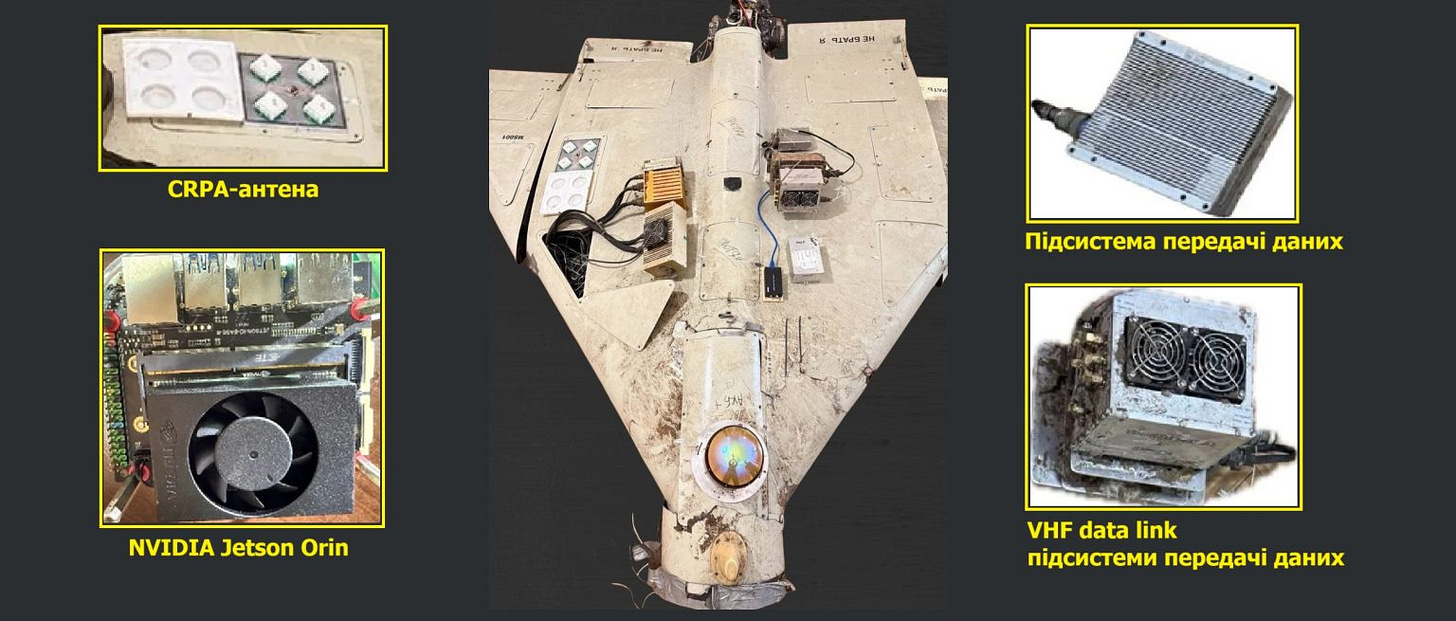Breaking: Russia’s “Digital Predator” Drone Uses Western AI
And Yes, Nvidia’s Jetson Orin Is the Brain
I spoke about this briefly in my “AI in Warfare” primer, which you can read here, but let’s start with the kind of headline that should have Western policymakers choking on their coffee: According to Ukrainian Major General Vladyslav Klochkov, Russia is field-testing a new kamikaze drone, the Shahed MS001, outfitted with an AI brain straight from Silicon Valley.
Specifically, the Nvidia Jetson Orin, a $600 edge AI superchip designed for hobbyists, students, and robotics nerds. Not, let’s be clear, for hunting Ukrainian APCs over the Donbas.
The MS001 isn’t just following GPS breadcrumbs to coordinates somebody uploaded the night before. This is, as Klochkov dryly notes, “a digital predator that sees, analyzes, decides, and strikes, without external commands.”
Not a loitering munition. Not a glorified bottle rocket. It’s a hunter-killer that, courtesy of Nvidia’s edge AI, weighs up targets on the fly, dynamically reroutes when jammed, and attacks high-value assets with disturbing autonomy.
“It Actually Thinks”: How Nvidia’s Jetson Orin Powers the Next Drone War
Let’s get under the hood. The Jetson Orin isn’t military tech, at least on the label.
Nvidia markets it as the brain for your next “smart robot,” not a Stalingrad-in-a-box. But the allure is obvious: up to 275 TOPS (trillion operations per second) of AI compute in a module that fits in your palm, sips power, and handles complex visual, thermal, and sensor fusion workloads with ease. Plug it into a drone and you’ve built the kind of flying machine that sci-fi promised, but modern war demands.
The MS001, powered by Jetson Orin, doesn’t just recognize a tank or a truck. It decides which one matters most, weighs trajectory and speed, and plots a final attack run, even if you jam GPS, block comms, or try to run away. It’s what happens when machine vision, sensor fusion, and edge AI leap out of the lab and onto the battlefield—thanks to a module you can order online if you tick the right boxes.
Jetson Orin comes in several flavors: AGX Orin, Orin NX, and Orin Nano. Each is optimized for a different AI budget and power envelope. At the top end, AGX Orin is a beast, running deep neural networks at warp speed, processing data from multiple cameras, lidar, radar, and other sensors all at once. Orin NX and Nano scale down the performance (and the price) but keep the same DNA. All are supported by Nvidia’s JetPack software stack, which gives you CUDA, TensorRT, cuDNN, and a plug-and-play SDK for everything from 3D perception to natural language processing.
Why do drone designers love it? Because the Jetson Orin is a complete edge AI solution in a package the size of a deck of cards, running on a few dozen watts of power, with support for Linux and a world of open-source libraries.
“Edge” computing means you don’t need a supercomputer in the cloud; you’ve got the equivalent of an AI research lab strapped to the belly of your drone. That means real-time object recognition, tracking, target prioritization, and autonomous navigation, even when the comms go dark.

The West’s Leaky Tech Embargo
Wait, how did Russia get its hands on this Nvidia tech?
Well, sanctions are a speed bump, not a wall; especially when it comes to “dual-use” tech like Nvidia’s Jetson Orin modules. Russia is getting these AI kits the same way rogue states have always gotten Western electronics: through a global maze of resellers, shell companies, “friendly” third countries, and a little thing called the grey market.
Let’s look a little deeper:




